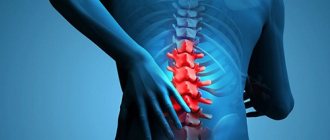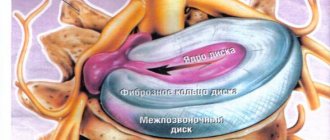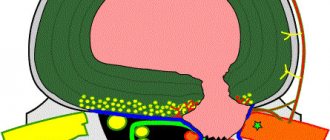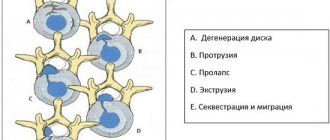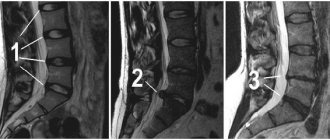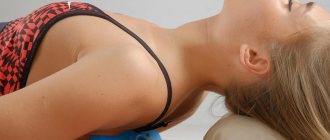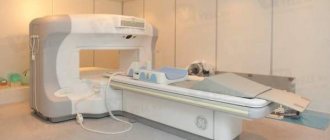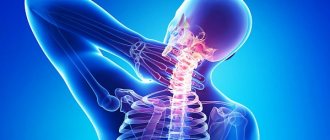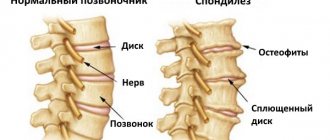Dorsal disc protrusion is a condition in which a damaged spinal disc, having lost the amount of fluid it needs to function, falls outside the vertebral body.
“Dorsal” protrusion is called because the disc protrudes dorsally, i.e. posteriorly, to the side where the spinal canal with the dura mater, spinal cord and spinal nerves is located. Protrusion is the process of destruction of the intervertebral disc and is the initial stage of development of a herniated disc.
Dorsal disc protrusion - what is it?
There are a large number of factors leading to the destruction of the intervertebral discs of the spine, but no matter what the reason or combination of reasons is the cause of the destruction, there is always a fairly typical algorithm for the damage and destruction of the intervertebral disc.
First of all, cracking of the outer shell of the disc (fibrous ring) occurs, as well as a parallel progressive loss of fluid from the central pulpous nucleus of the disc, without which the disc is not able to perform its functions.
The result of the disc losing fluid from the nucleus pulposus is a decrease in its shock-absorbing properties and it is squeezed out. Thus, a protrusion is formed directed towards the spinal canal area.
Causes of diffuse protrusion
This pathology is considered a consequence of the influence of many negative factors . The main ones can be identified:
- Osteochondrosis.
- Osteoporosis.
- Spinal injury.
- Congenital anomalies of body structure.
- Pregnancy period.
- Difficult birth.
- Age-related changes.
This disease often occurs in people who have a genetic predisposition to it. In this case, the discs fall out due to weak muscles, brittle bones and weak ligaments. This is influenced by environmental factors, which can be endogenous and exogenous.
| Endogenous. Congenital defects or abnormalities in physiological structure : | |
| Involutional | The L5‒S1 disc falls out, since the ligamentous-muscular system is not sufficiently developed. Degradation extends to the lumbar and thoracic regions. |
| Biochemical | The disc is destroyed from lack of nutrients. Gout occurs, and cracks appear on the surface of the disc. |
| Vascular changes | Tissue nutrition is significantly reduced. Functional properties are lost, and disc protrusion begins. There is also a lack of moisture, which accelerates the displacement of the core. |
| Hormonal | Restructuring of this system causes diffuse lesions. Often the cause is thyroid disease, pregnancy and menopause. |
| Hereditary | These factors provoke abnormal development of the vertebrae: extra processes, incomplete ossification, fusion of the L5‒S1 discs. |
| Exogenous. Violations develop due to low activity and aggressiveness of external factors : | |
| Infectious | Inflammation occurs throughout the body, not just in the spine. Depreciation loads increase, which provokes the appearance of cracks in the discs. |
| Chemical | Allergic reactions occur that cause inflammation. Diffuse protrusion forms in weak areas of the spine. |
| Physical | Excessive physical activity, incorrect posture and weak muscle frame. |
All these reasons violate the integrity of the discs and cause protrusion of the nucleus pulposus.
Mechanism of occurrence
In the lumbar and cervical spine, the pulpous nuclei of the intervertebral discs (if you look at the spine from the side) are not located strictly in the middle, but are shifted somewhat posteriorly in order to create the correct physiological curves in the spine - cervical and lumbar lordosis.
That is why, when the height of the disc decreases, which occurs when it is destroyed, part of the disc with the nucleus begins to be squeezed out mainly posteriorly, i.e. dorsally.
This condition is provoked by particular inclined positions of the torso (working “inclined”) or head (working at a computer).
Straightening the physiological curves in the cervical and lumbar spine is also of great importance, which very often happens with osteochondrosis.
In the thoracic spine, where the nuclei pulposus are somewhat displaced anteriorly, dorsal protrusions are much less common.
Therapy methods
Did you know that...
Next fact
Dorsal protrusions require an integrated approach , which will ensure the effectiveness of treatment. First, measures are taken to relieve pain and improve the patient’s condition. The next stage of therapy is aimed at restoring the spine and normalizing blood circulation in the spinal column.
The following techniques are used to treat dorsal protrusions::
- Massage.
- Exercise therapy.
- Manual therapy.
- Vacuum therapy.
- Physiotherapy.
Drug therapy
As for drug therapy, it is used only to eliminate the pain that is characteristic of this pathology. Medicines also relieve inflammation and improve blood flow at the site of the lesion.
Basically, chondroprotectors, anti-inflammatory non-steroidal drugs and vitamin complexes that strengthen cartilage tissue are prescribed.
Medicines are selected only by the attending physician , who takes into account the characteristics of each specific case. To eliminate pain and inflammation, warming ointments are used - Voltaren, Fastum gel and others. Such products are applied to the inflamed area.
If necessary, drugs with similar effects are administered intravenously. Blockades are often practiced, where medicine is injected into the affected nerve.
Surgery
Only at the first stage of the disease can surgical intervention be avoided. If the disease is advanced, it is difficult to do without surgery. Indications for its implementation are the presence of a large protrusion and severe pinched nerves that are not amenable to traditional treatment, as well as the threat of paralysis.
The operation, of course, is performed in a hospital under general anesthesia (very rarely under local anesthesia). The surgeon removes the affected tissue and replaces this area of the spinal column with prosthetics.
The following types of surgical intervention are used:
- Endoscopy.
- Discectomy is standard.
- Microdiscectomy.
If the protrusions are too large, it is possible to perform surgical intervention - discectomy
Rehabilitation takes up to 6 months. During this period, the patient is under observation.
Exercise therapy and massage
If you have a problem with the spine, exercise is an effective and common method of physical therapy. Exercise therapy strengthens the muscle frame, normalizes blood flow in affected tissues, restores motor activity and relieves muscle spasms.
Recommendations for proper exercise performance:
- During an exacerbation, gymnastics is prohibited.
- Loads should be increased gradually.
- Strength exercises should be avoided.
- You need to train regularly.
- If your health worsens, you should stop exercising and consult a doctor.
The set of exercises should be selected by the attending physician, taking into account the characteristics of the patient and the clinical picture of the pathology. Breathing exercises have proven themselves to be excellent.
A good method is spinal traction . If it is performed correctly, then injuries and complications are completely excluded.
To stop the protrusion process, you must do a massage. A relaxing and warming massage is best. As a result of this procedure, destructive processes stop.
The effect of massage movements will be noticeable after 10 sessions. Please note that the massage must be performed by an experienced master. .
Video: “Where to start treating spinal disc protrusion and herniation”
Find out more about treating disc protrusions:
- Symptoms and treatment of intervertebral protrusion in the thoracic region
- More about exercise therapy classes for protrusion of neck discs on the page
- You will find the technique for performing exercises for protrusions in the lower back here
Self-treatment with folk remedies
There are also folk methods for protrusion, but we should not forget that they should be used as a complement to traditional treatment.
The most effective recipes:
- Turpentine bath.
- Garlic compress.
- Compress with Kalanchoe leaves.
- Rub onion with honey.
Sometimes patients are contraindicated from taking pharmaceutical drugs containing chemical components. In this case, you have to prepare natural internal remedies yourself.
Herbal mixture of horsetail and nettle leaves . The components are mixed in equal proportions and poured with boiling water. The decoction is taken half a glass twice a day.
Regenerating elixir . Mix 20 grams of comfrey root, 50 ml of aloe juice and a glass of honey. Take a teaspoon in the morning.
Before using folk remedies, it is advisable to first consult a doctor.
Prevention
Preventive measures play an important role in preventing the development of protrusions. To avoid this unpleasant disease, you need to follow certain rules and perform the necessary procedures.
To avoid degenerative changes in the intervertebral discs, it is necessary to strengthen the muscle corset. What is needed:
- Strengthen the muscle corset.
- Avoid physical inactivity.
- Perform the permitted exercises daily.
- Normalize your weight.
- Avoid heavy loads.
- When working sedentarily, do a periodic warm-up.
- It is advisable to visit the pool.
- Forget about bad habits.
Yoga and kinesiotherapy, which is a modern form of exercise therapy that combines knowledge of physiology, anatomy and medicine, are very useful. By the way, therapeutic exercises must be performed throughout life to prevent relapse of the pathology.
Symptoms
Symptoms of dorsal protrusions depend on the direction of extrusion of the protrusion.
- If the protrusion is directed strictly posteriorly , then it causes muscle tension, irritating the posterior longitudinal ligament running along the edge of the vertebra. With loads, heavy lifting, or working in a forced position of the torso, already formed muscle tension can increase many times and manifest itself as pain. Depending on the degree of disc destruction, pain can be strong or weak, be present for a long time after the exercise itself, or pass quickly.
- If the protrusion is shifted slightly to the side from the central line , then the extruded intervertebral disc is close to the nerve emerging from the spinal cord. In this case, with the development of inflammation or swelling, the dorsal protrusion will take part in irritation and/or compression of the nerve, causing pain that will not only be located at the site of inflammation, but also spread to the periphery (to the shoulder, arm, buttock, thigh or leg). In this case, the pain can be quite severe and long-lasting, and it will be difficult to distinguish it from a progressive herniated disc.
FAQ
How to relieve pain from a dorsal hernia?
The most effective method is paravertebral blockades, which are performed only in medical institutions. At home, you can use non-steroidal anti-inflammatory drugs.
Is there a chance to cure a dorsal hernia without surgery?
In some cases, it is possible to avoid surgery for a dorsal hernia. Timely initiation of conservative therapy can delay surgery or help avoid it. In advanced cases, if complications occur, surgical intervention is mandatory.
How long does the recovery period take after surgery?
The early postoperative period is one to two weeks. In favorable cases, complete recovery requires 4-6 weeks. With a less favorable outcome, rehabilitation may take up to six months.
Themes
Intervertebral hernia, Spine, Pain, Treatment without surgery Date of publication: 11/12/2020 Date of update: 12/23/2020
Reader rating
Rating: 5 / 5 (2)
Diagnostics
Dorsal protrusion can be objectively diagnosed only with an MRI or computed tomography examination. Radiographs do not show posterior protrusions.
On Rg images, dorsal disc protrusions can be judged only on the basis of indirect signs.
Since it is very difficult to distinguish a dorsal protrusion from a formed spinal hernia based on complaints and symptoms, all patients who first complain of pain in the spine must undergo an MRI examination, this will allow identifying the protrusion at an early stage of development, which means timely treatment aimed at curing it. .
Approach to treating the disease in our clinic
The Paramita clinic has developed a unique approach to the treatment of dorsal hernias. This:
- thorough preliminary examination of the patient using instrumental studies and oriental methods;
- development of an individual treatment plan for each patient, taking into account the characteristics of the disease;
- using a treatment complex that includes advanced European techniques and traditional Eastern methods, which allows you to get rid of a hernia and improve the health of the body as a whole.
We eliminate pain during the first visits to the doctor.
Treatment of dorsal disc protrusion
Correct treatment of dorsal disc protrusion in its tactics usually differs little from the treatment of intervertebral disc herniation.
Since the main problem in the development of dorsal (i.e., posterior) disc protrusion is damage to the posterior parts of the intervertebral disc with its extrusion into the spinal canal, the main basic treatment must necessarily be aimed at this particular damage. For proper treatment of dorsal protrusion of the spine, it is first necessary to carry out a “preparatory” stage of treatment, the task of which is to remove pain, the inflammatory process, relieve increased muscle tone, swelling, eliminate the lack of blood supply to the spinal tissues in the disease areas, after which the main, “restorative” stage treatment. The task of the “restorative” stage of treatment is to heal damage to the outer fibrous ring of the disc and restore the nucleus pulposus of the disc, without which the intervertebral disc will not be able to fulfill its shock-absorbing properties and, in this case, will still remain squeezed out.
The method of treatment of dorsal protrusions used in the clinical diagnostic Center of Dr. Yavid takes into account not only all the symptoms of the disease, but also all the reasons leading to its appearance.
The most innovative and effective technique used at Dr. Yavid’s clinic today is the “revitalizing” technique, aimed not only at relieving symptoms, but also at permanently restoring damaged intervertebral disc tissue.
Sign up and come see us! We help!
Reasons for development
A dorsal hernia does not occur on its own. The exact reason why this particular type of pathology develops has not yet been found. There are a number of factors that contribute to its appearance. These include:
- Genetic factor.
- Impaired metabolism or nutrition of the disc.
- Mechanical impact.
As for the genetic factor, a family predisposition of people to the occurrence of hernias has been proven. If one or both parents had this disease, there is a high chance that their children will also develop it as they grow older. This is due to individual characteristics of the structure of the spine, ligamentous apparatus and predisposition to degenerative processes in general. In some people, the body ages faster, in others - more slowly. This is a genetically determined process. As well as the occurrence of osteochondrosis and spinal hernias.
Metabolic disorders are one of the main factors. On average, obliteration of the vessels supplying the intervertebral disc ends at 27 years of age. After this, the disc is not supplied with blood, but receives nutrients from the surrounding tissues. Metabolism occurs during movement. The higher the physical activity, the less chance of metabolic disorders in the intervertebral discs. In people with low physical activity, hernial protrusions occur more often.
Mechanical impacts mean not only injuries, but also excess weight. Dorsal hernias most often occur when the injury does not occur on the spine itself, but lies in an axis parallel to it. For example, when jumping from a height or hitting the parietal part of the head. Excess weight is also a mechanical impact on the spine. Lifting heavy objects is also dangerous.
Prevention
The main problem of prevention for posterior disc protrusions is maintaining proper muscle tone and posture. This may involve playing sports, therapeutic exercises or yoga.
This is especially important if the patient has a curvature of the spine (scoliosis). It is advisable to avoid prolonged positions with the torso tilted forward and the head tilted forward, since it is these loads that primarily provoke the formation of posterior disc protrusions.
If you experience even minimal complaints from the back, lower back or neck, you should definitely consult a doctor who specializes in spine diseases. The sooner protrusion is diagnosed and the sooner treatment is started, the more effective and quick the treatment result will be.
Surgery
The operation is performed in the absence of a positive effect of conservative therapy carried out for six months or more, as well as in the case of rapid progression of protrusion.
The following types of surgical intervention are used:
- Hydroplastics. A special substance is injected into the damaged disc, which washes away the destroyed tissue. As a result, the protrusion decreases in size and painful symptoms disappear.
- Cold plasma nucleoplasty. Plasma is injected into the affected disc, it evaporates the damaged areas of the nucleus pulposus. The protrusion becomes smaller, the patient's condition improves.
- Laser vaporization. It is used in the initial stages of pathology. The bulging pulp is burned out with a laser beam.
To obtain a good therapeutic effect, it is better to treat circular disc protrusion in clinics in the Czech Republic. Complex therapy and modern European techniques, highly qualified doctors are the key to recovery. This approach allows you to relieve the symptoms of protrusion, achieve remission for a long time and return to your normal lifestyle.
Diet therapy
There is no special diet for the treatment of circular protrusion. But it is necessary to adhere to the principles of proper nutrition. The diet must be balanced, contain vitamins and minerals, proteins, fats and carbohydrates in the right proportions.
It is important to normalize body weight, since excess weight causes excessive stress on the spine, which has a bad effect on already damaged intervertebral discs.
For degenerative diseases of the spine, you must eat:
- Calcium. Contained in eggs, cottage cheese, cabbage, cheese.
- Magnesium. It is recommended to eat spinach, cucumbers, and sunflower seeds.
- Vitamin D and phosphorus. They are present in large quantities in such varieties of fish as trout, salmon, cod, and pink salmon.
Jelly-like products are useful for tissue restoration - jelly, jellied meat, regular jelly. They supply the body with substances that are necessary for the regeneration of cartilage tissue.
Proper nutrition during protrusion
Products containing:
- calcium - oranges, cucumbers, cabbage, beans, eggs;
- manganese - nuts, beans, celery, potatoes;
- phosphorus - spinach, wheat, bran, peas;
- magnesium - sunflower seeds, honey, raisins;
- vitamins A and D - fruits, vegetables, butter, whole milk;
- vitamin C - garlic, citrus fruits, berries;
- B vitamins - oats, corn, beef, pork.
High-grade flour, sugar, coffee, fast food products, as well as fatty, fried and salty foods are prohibited.
Why does protrusion develop?
Previously, it was believed that age was the main risk factor for the occurrence of protrusion, but it is now noted that the disease can also affect a young body.
The following main factors lead to the development of protrusion:
- Incorrect posture;
- Back injuries;
- Obesity;
- Heavy heredity;
- Underdevelopment of body muscles;
- Metabolism deficiencies;
- Severe infectious diseases;
- High loads on the back (sports can also have negative consequences);
- Physical inactivity.
Clinical manifestations
Dorsal and other cervical disc protrusions have a number of clinical manifestations, expressed as follows:
- pain symptoms of an acute or chronic nature, spreading to the shoulder and upper limb;
- a feeling of stiffness and limited movement in the neck;
- numbness of the neck and arms;
- weakness of the upper limbs;
- headaches in the back of the head, dizziness;
- surges in blood pressure.
It is worth noting that this pathology can pose a danger to health and life, since it can lead to compression of the vertebral artery, which supplies blood to the back third of the brain. Sometimes this condition can cause a stroke.
Recovery prognosis
Without treatment, the prognosis is disappointing. If you leave things to chance, your health will worsen and the risk of complications will increase. Thus, the disease can lead to overload of the spine and the development of multiple protrusions , from which intervertebral hernias subsequently form . Early diagnosis minimizes the likelihood of complications and increases the chances of remission, even without surgical and drug treatment.
